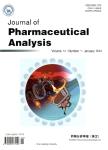Stability study on an anti-cancer drug 4-(3,5-bis(2-chlorobenzylidene)-4-oxo-piperidine-1-yl)-4-oxo-2-butenoic acid (CLEFMA) using a stabilityindicating HPLC method
Stability study on an anti-cancer drug 4-(3,5-bis(2-chlorobenzylidene)-4-oxo-piperidine-1-yl)-4-oxo-2-butenoic acid(CLEFMA) using a stabilityindicating HPLC method作者机构:Department of Pharmaceutical Sciences University of Oklahoma Health Science Center 1110 N. Stonewall Avenue Oklahoma City OK 73117 USA
出 版 物:《Journal of Pharmaceutical Analysis》 (药物分析学报(英文版))
年 卷 期:2017年第7卷第1期
页 面:1-9页
核心收录:
学科分类:0710[理学-生物学] 1007[医学-药学(可授医学、理学学位)] 1002[医学-临床医学] 081704[工学-应用化学] 07[理学] 0817[工学-化学工程与技术] 08[工学] 070302[理学-分析化学] 0703[理学-化学] 0702[理学-物理学] 10[医学]
基 金:partially funded by a grant from National Heart Lung & Blood Institute [R01HL104286]
主 题:CLEFMA HPLC Stability Shelf-life Isomerization
摘 要:CLEFMA, 4-(3,5-bis(2-chlorobenzylidene)-4-oxo-piperidine-1-yl)-4-oxo-2-butenoic acid, is a new chemical entity with anti-cancer and anti-inflammatory activities. Here, we report its stability in solution against stress conditions of exposure to acid/base, light, oxidant, high temperature, and plasma. The identity of the degradation products was ascertained by mass and proton nuclear magnetic resonance spectroscopy. To facilitate this study, we developed and validated a reverse phase high performance liquid chromatography method for detection of CLEFMA and its degradation. The method was linear over a range of 1–100 μg/m L; the accuracy and precision were within acceptable limits; it was stability-indicating as it successfully separated cis-/trans-isomers of CLEFMA as well as its degradation product. The major degradation product was produced from amide hydrolysis at maleic acid functionality caused by an acidic buffer, oxidant(3% hydrogen peroxide),or temperature stress(40–60 °C). The log k-p H profile showed that CLEFMA was most stable at neutral p H. In accelerated stability study we found that the shelf-life(T_(90%)) of CLEFMA at 25 °C and 4 °C was 45 days and220 days, respectively. Upon exposure to UV-light(365 nm), the normally prevalent trans-CLEFMA attained cis-configuration. This isomerization also involved the maleic acid moiety. CLEFMA was stable in plasma from which it could be efficiently extracted by an acetonitrile precipitation method. These results indicate that CLEFMA is sensitive to hydrolytic cleavage at its maleic acid moiety, and it is recommended that its samples should be stored under refrigerated and light-free conditions, and under inert environment.



